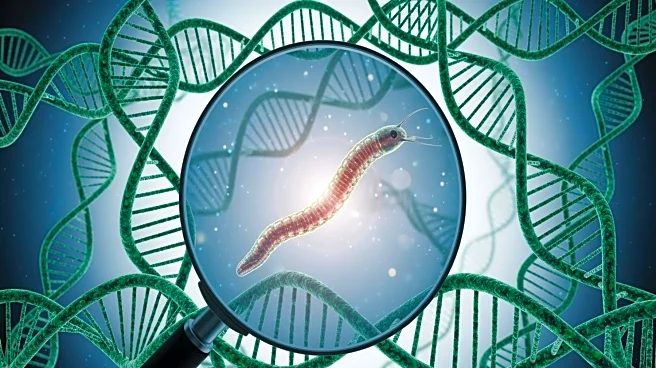What's Happening?
An international research team led by Hiroki Shibuya, PhD, at the RIKEN Center for Biosystems Dynamics Research has discovered a novel genetic mechanism in the roundworm C. elegans. The study, published in Science, reveals that vital RNA needed for telomere
maintenance hitchhikes within another gene's intron, rather than having its own gene. This discovery suggests that DNA hitchhiking could be a common strategy across the animal kingdom, with potential implications for anti-aging therapies and regenerative medicine in humans. Telomeres, which protect chromosome ends, shorten with each cell division, leading to cellular senescence. However, germ cells use telomerase to maintain telomere length, ensuring species survival. The research identified an intronic long noncoding RNA, termed terc-1, within the intron of the nmy-2 gene, which is expressed in germ cells. This mechanism, termed 'intron hitchhiking,' may reflect a broader strategy used by noncoding RNAs involved in germline development.
Why It's Important?
The discovery of the intron hitchhiking strategy in C. elegans offers significant insights into telomere biology and species survival. Understanding how telomerase RNA is regulated in germ cells can transform approaches to aging, fertility, and regenerative medicine. This mechanism highlights the evolutionary adaptability of telomerase RNA and suggests that similar strategies may be used by other noncoding RNAs across different species. The findings could lead to new methods for controlling telomerase activity, potentially impacting treatments for age-related diseases and improving human healthspan. By revealing how telomerase RNA is embedded within introns, the study provides a new perspective on genetic regulation and its role in maintaining cellular immortality.
What's Next?
Future research may explore whether similar intron hitchhiking mechanisms exist in other species and how they contribute to genetic regulation and species survival. Scientists may investigate the potential for manipulating telomerase activity in humans to develop anti-aging therapies. Additionally, understanding the genomic context of telomerase RNA expression could lead to advancements in regenerative medicine, offering new strategies for tissue repair and longevity. The study opens avenues for exploring the role of noncoding RNAs in heritable trait transmission and their impact on evolutionary biology.
Beyond the Headlines
The discovery of telomerase RNA hitchhiking within introns challenges traditional views of genetic regulation and highlights the complexity of RNA functions in cellular processes. This mechanism underscores the importance of noncoding RNAs in genetic evolution and their potential role in species adaptation. The findings may prompt a reevaluation of how genetic information is organized and expressed, influencing future research in molecular biology and genetics.
















